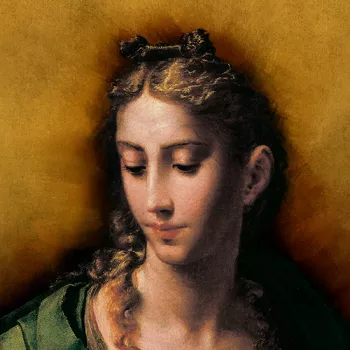The Libyan Sibyl 1651
Oil on canvas | 116.3 x 96.5 cm (support, canvas/panel/stretcher external) | RCIN 405340
-
This late work by Guercino ('The Squinter') is one of a pair of Sibyls painted for Ippolito Cattani of Bologna. It depicts the Libyan Sibyl who prophesied the coming of Christ to the Gentiles. She is usually shown holding a lighted torch, but Guercino identifies her here by the inscription on the book.
This painting depicts one of the twelve Sibyls, who were the seers of classical antiquity alleged to have foretold the coming of Christ, and were thus adopted by the Church as pagan equivalents of the Old Testament prophets. Michelangelo alternated prophets and Sibyls on the ceiling of the Sistine Chapel, a prototype which may explain the great popularity of the subject over the next two hundred years. Guercino painted Sibyls throughout his career, especially in the 1640s and 1650s. The Libyan Sibyl had prophesied the manifestation of Christ to the gentiles. Guercino has not included her usual attribute of a lighted torch here, identifying her instead by means of the inscription on the book.
This is an example of Guercino's late work, in which the strong chiaroscuro of his early years has been lightened with paler tonalities and his style has become refined and classical. The effects of light and dark, with the Sibyl's face caught in half-shadow, recall his earlier work, but are more subtle, the handling of paint more delicate and economical. The sensuality of the flesh and the warmth of the drapery give the figure more humanity than comparable figures by Guido Reni: the cool blue of her dress is set off by the striking clash of colours in the pastel pink and orange brown of her mantle and the deep red, possibly velvet, of her dress. The few colours are subtly modulated and simply counterbalanced by the white of her turban and the knotted sash at her waist. The Sibyl has a noble grandeur despite the modest size of the painting. Her concentration on her reading, oblivious of the viewer, gives a poetic quality to the painting. The Sibyl's dress was originally higher across her left shoulder, but there appear to be few other visible pentimenti.
The painting has been identified as one of two half-length Sibyls painted for Ippolito Cattani (or Cattanio) of Bologna, for which Guercino received 120 ducatoni (or 150 scudi) on 4 December 1651. The pendant is The Samian Sibyl (private collection): the pairing was apt, since both Sibyls were associated with the island of Samos. A workshop replica of The Samian Sibyl was sold to the Grand Duke of Tuscany in 1777 and appears in the foreground of Johan Zoffany's Tribuna also in the Royal Collection of c.1772-8, possibly as a compliment to King George III on his excellent purchase of the present work. Whereas the Libyan Sibyl remains absorbed in her reading, the Samian Sibyl looks heavenwards, her hands resting on her book, her turban a rich green and red. Both works have the distinctive spelling of the word 'sibyl' as 'sybilla', which Guercino seems to have corrected a few years later to 'sibylla'.
The painting appears in Pyne's illustrated Royal Residences of 1819, hanging in the Second Drawing Room at Buckingham Palace (RCIN 922143).
Catalogue entry adapted from The Art of Italy in the Royal Collection: Renaissance and Baroque, London, 2007Provenance
Ippolito Cattani, 1651; probably bought for George III by Richard Dalton in Italy, early 1760s; recorded in the Warm Room at Buckingham Palace in 1790
-
Medium and techniques
Oil on canvas
Measurements
116.3 x 96.5 cm (support, canvas/panel/stretcher external)
147.0 x 127.1 x 10.5 cm (frame, external)










